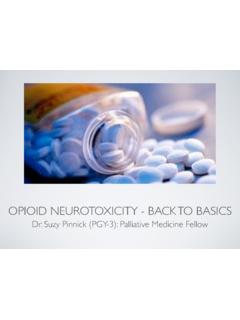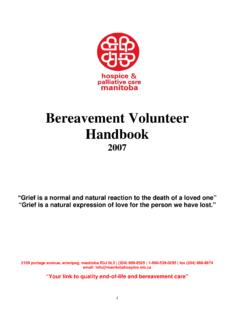Transcription of A Timeline of Hospice Palliative Care Policy and Practice ...
1 [ Dr. Allison Williams School of Geography and Earth Sciences McMaster University Hamilton, Ontario, Canada Dr. Mary Lou Kelley Sarah Dykeman Lily DeMiglio February, 2010 A Timeline of Hospice Palliative care Policy and Practice in Ontario, Canada 2 Prologue List of Acronyms CCAC- Community care Access Centre CCB- Compassionate care Benefit CCO- Cancer care Ontario HAO- Hospice Association of Ontario HPC Hospice Palliative care HPCN- Hospice Palliative care network MOHLTC- Ministry of Health and Long-Term care OPCA- Ontario Palliative care Association PCIP- Palliative care Integration Project This report examines the evolution of Hospice Palliative care in Ontario, Canada. As you will notice, several sections will appear in boxes, or within parentheses.]
2 Boxes with a tree symbol highlight the Hospice Palliative care progress specific to rural Ontario, whereas boxes featuring a map of Canada illustrate federal level events. Parentheses encompass italicized text which are direct quotes from key informants who contributed their knowledge of Hospice Palliative care to this project. Introduction Ontario is Canada s most populated province, having approximately 12 million residents. Most Ontarians, however, live in or around urban areas; the majority of the province s land area is sparsely populated. Demographically, Ontario represents 40% of the Canadian population [1]. Of that, almost 85% of Ontarians live in urban settings, with 15% living in rural areas as of 2006 [2]. The vast distances and low population density in these areas makes delivering health care services in rural Ontario, including Hospice Palliative care (HPC), a significant challenge for health Policy makers and program planners and providers.
3 Although there are both rural and urban communities in Southern and Northern Ontario, Northern Ontario is predominately comprised of rural communities while Southern Ontario is mostly urban. As depicted in Figure 1, the province of Ontario is divided into fourteen Local Health Integration Networks (LHINs), who are responsible for planning health services in their jurisdiction. As seen in Figure 1 (pg 12), the two LHINs in Northern Ontario serve the largest areas due to low population densities. As a result, much of the progress and program innovation specific to HPC has taken place in the urbanized southern region of Ontario. The Rural Picture: Rural Canada is home to a high proportion of seniors. Statistics from 2006 show that 33% of the total number of Canadian seniors live in rural areas, accounting for 15% of the population in rural areas; by comparison, seniors only constitute 13% of the population in urban areas [3].
4 In Ontario, the population of seniors in predominantly rural regions was 16% in 2006, about 1% above the average for Canada [3]. Rural citizens in Ontario advocate that the general lack of health care services, providers, and Hospice Palliative care (HPC) education and training, in particular, limit the quality and extent of HPC care that is provided to dying people in their home communities. In rural First Nations communities, a lack of resources is complicated by jurisdictional issues between the provincial and federal governments. 3 Moreover, Ontario is in a unique position, both geographically and politically, because Ottawa, the nation s capital is located within its boundaries. In effect, the evolution of HPC in Ontario has been influenced by the proximity of the capital city as it is the venue for national Policy changes.
5 Although the term Palliative care was coined by Dr. Balfour Mount, in Montreal Quebec in 1976, it was the Palliative care Foundation, based in Toronto, (now the Ontario Palliative care Association -OPCA) that defined the term in 1981. The demand for HPC services in Canada has been exacerbated by an aging population, increased life -expectancies of those with chronic and/or terminal illnesses and the shift of care from hospitals to homes. In 2007, there were million senior citizens in Ontario ( of Ontario s population) and population projections show that by 2031 there will be million senior citizens ( of the population). The bulk in the projected growth of the senior population is set to take place after 2011 as baby boomers approach their 65th birthdays [4]. To study and track the influence of past policies on the development and progression of current HPC practices , this study was undertaken to examine the evolution of HPC in seven provinces, the latter which were selected based on their representation of Canada s regional diversity (British Columbia, Alberta, Saskatchewan, Manitoba, Ontario, Quebec and Prince Edward Island).
6 Interviews were conducted with a number of key informants, which included individuals who were identified as knowledgeable with regard to HPC development in their province. In addition to information provided by key informants, a review of both the academic and grey literature was used to compile a list of key events in order to develop HPC timelines for each province. Despite our efforts, fragmented documentation combined with the need to rely mostly on key informant accounts made the tracking of HPC evolution a difficult endeavor. As a result, it is acknowledged that what has been presented herein has clear limitations. For this reason we encourage readers to share with the research team any information that they feel has been overlooked or misinterpreted (please refer to page 10 for contact information).
7 This report presents the findings specific to the evolution of HPC in Ontario. As you will note in the table below, the HPC movement began in the late 1970s with most of the foundational groundwork being laid in the 1980s. You know the whole Policy change[d] in Ontario with the Palliative care initiatives to make it easier for people to remain at home if they wished- a societal shift (key informant) Palliative care is active compassionate care of the terminally ill at a time when they are no longer responsive to traditional treatment aimed at cure and prolongation of life and when the control of symptoms, physical and emotional, is paramount. It is multidisciplinary in its approach and encompasses the patient, the family and the community in its scope (Ontario Palliative care Association) 4 Key Provincial Milestones Below is a list of main events that have helped to shape HPC in Ontario, presented in chronological order.
8 These events were noted by key informants and verified in both the grey and academic literatures. It should be acknowledged that the following list of events is provincially based. Federal initiatives and contributions to these events, although not listed in the table below, will be highlighted in the following section. Table 1. Chronological Key Provincial HPC Events 1979 First community based Hospice opens The Hospice of Windsor and Essex County 1981 Palliative care Foundation forms and is based in Toronto; defines Palliative care ( Palliative care Foundation now the Ontario Palliative care Association) 1983 First University Institute for HPC research and education forms at the University of Ottawa 1985 Palliative care Foundation publishes first issue of the Journal of Palliative care .
9 The issue is dedicated to Dame Cicely Saunders for her instrumental role in the United Kingdom HPC movement 1989 Hospice Association of Ontario (HAO) is founded by nine members 1992 Ministry of Health announces $ million in funding for four HPC education initiatives including: education initiatives for interdisciplinary providers, education for family physicians, support and maintenance of Hospice volunteer visiting programs, and the establishment of regional pain and symptom management teams 1999/2000 Cancer care Ontario (CCO) and other stakeholders devise the Palliative care Integration Project (PCIP), an intervention that promoted the use of common tools and guidelines, and implement it in Southeastern Ontario 2004 CCO identifies HPC as a priority area for the first time 2004 Compassionate care Benefit (CCB) made available to Ontarians 2005 Ministry of Health and Long-Term care (MOHLTC) announces the End of life (EoL)
10 care Strategy pledging $ million in funding over the following three years to EoL care , including $ million in funding for nine residential hospices. The purpose of the EoL care Strategy is to achieve the MOHLTC goals, including integration, coordination and quality of care . 2005 14 Hospice Palliative care Networks (HPCNs) established for each Local Health Integration Network (LHIN) by MOHLTC 2006 Provincial PCIP program launched, integrating the HPCNs, Regional Cancer Programs and the Community care Access Centres (CCACs) with support from the MOHLTC and CCO 2006 Family Medical Leave and CCB are amended to make employees eligible to care for extended family members and those who are considered as family 2007 MOHLTC expands funding from nine residential hospices to 15 organizations 2008 The EoL care Strategy ends.












